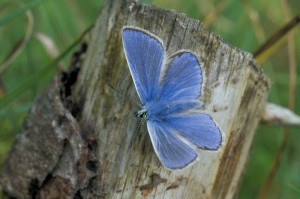Small Blue in the North Highlands
For those that remember me puzzling how the Small Blue butterfly can survive with such an apparently limited range in the North, the answer appears to be that they might not. You may be interested in the story of The Scottish Wildlife Trust and Butterfly Conservation Scotland transporting butterflies from Morayshire to Ayrshire at:
www.bbc.co.uk/news/uk-scotland-glasgow-west-23317318
Old stories and records suggest that there was a wider range in the north, including Farr, Reay and the East coast fishing stations. However there doesn’t appear to be any verifiable contemporary accounts from anywhere other than Scrabster and Dunnet. There also appears to be a lack of Kidney Vetch on the East coast: confirmed by Ben Macgregor (Ralph), who probably knows it better than anybody living.
There is a problem with identification for anybody who hasn’t seen the butterfly in the wild. It could easily be confused with the female Common Blue, or even the Chimney-sweeper moth – if it occurs in the North.
As you will see from the Ayrshire example, not least of the wee creature’s troubles, stems from choosing such an erratic host plant. Kidney Vetch thrives on fresh poor soil – it loves the eroding cliffs behind Scrabster – and it can’t take competition from rampant herbage. It established itself on the roadside East of Forse River at Westfield for a few years, and then disappeared last year.
It is probable that the butterfly’s survival will depend on human management aiming at extending its range, and even linking the colonies. Some good work has been done by planting in Scrabster, Dunnet Forest and Castlehill. I’ve also heard that Rosemary Smith has been planting near the bird sanctuary beside St John’s Loch. Curiously the Butterfly Conservation distribution map has only one arrow in the North pointing to that site. Perhaps it might be possible to extend the range from Scrabster to Thurso East by linked planting: given the cooperation of the Council and volunteers. Fortunately the plant is easy to grow and establish – as testified by Phyllida for the Planting the Future garden at High Ormlie. Any further work would probably require the help of big guns like SWT and BCS. If they can transplant from Morayshire to Ayrshire, then surely it would be easy to re-establish colonies at Reay and Melvich, or anywhere else with thriving host plant.
Finally there is still a need for more monitoring and searching for more colonies; it would be great to be proved wrong about the old sites. Now is the time to be doing it, and they choose the nicest of habitats for humans too.
Tony Bradford